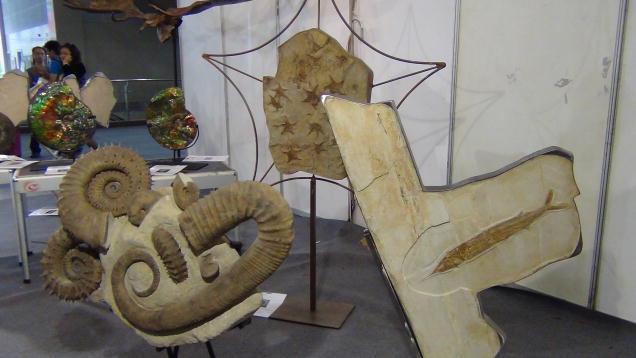Conference Report: 2013 China Mineral & Gem Show in Changsha
July 31, 2013

one of the world's largest rhodochrosite specimens. Photo by Tao Hsu.
The exhibition center was divided into several sections, with themes such as mineral specimens, fossils, museum procurement, the mineral resources of Hunan province, and gems and jewelry. Numerous mineral, fossil, and gemstone dealers brought their rarest collections to the show.
Wayne C. Leicht from Kristella and Crystal Classics debuted the largest known natural gold specimen, a 77 oz. piece found in California in 2012. Also on display was the “Empress of China,” discovered in Guangxi province in 2009, one of the world’s largest crystallized rhodochrosite specimens. The owner, Collector’s Edge Minerals, Inc., brought it back to China for a reunion with its companion piece, the “Emperor of China.” Numerous other Chinese and international mineral dealers presented their best-quality specimens, including tanzanite crystals, various colors of fluorite, calcite in exotic shapes, the world’s largest gypsum specimen, ruby in calcite, watermelon tourmaline, and aquamarine.
In a fossil pavilion covering more than 3,000 square meters, some 50 international dealers displayed their large specimens to professional buyers and the public, with the Chinese debut of the Archaeopteryx bird fossil as the hub. The exhibitors supplied extremely detailed descriptions of the important displays, which effectively connected three realms: the fossil market, science, and education.

The Changsha show featured a large fossil pavilion. Photo by Tao Hsu.
In the gem and jewelry section, Cody Opal organized a special exhibition featuring more than 20 Australian dealers. One of their highlights was an 11,340.95 ct black opal, the world’s largest. Damien Cody showed the contributors one of the finest black opals from the collection. The piece had a very homogeneous black background with breathtaking play of color spanning the entire spectrum. Jadeite and nephrite dealers from mainland China, Taiwan, Hong Kong, and Myanmar exhibited goods of different qualities. Some of them showed these contributors how to evaluate the quality and value of Asia’s two most popular gems by looking at their color, transparency, and texture. Buyers and the public could even play the “gamble stone” game onsite. Overall, colored stone wholesalers and high-end retailers from mainland China showed their resolve to develop the Chinese colored stone industry.The main show was accompanied by other events intended to spark interest in minerals and jewelry and Earth sciences in general. The theme of the CMGS International Summit Forum was “Mineral & Fossil and Scientific Civilization.” Government delegates and industry experts from the United Nations, China, Australia, Canada, South Africa, Brazil, Tanzania, the United States, and Sri Lanka joined this event. GIA’s distinguished research fellow, Dr. James Shigley, spoke about the institute’s mission, and educational and laboratory services.
Encouraged by the success of this inaugural show, the Hunan government plans to hold the second CMGS May 15–19, 2014.



